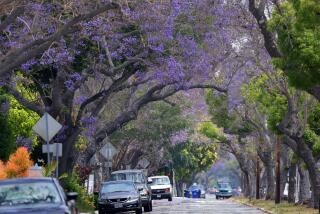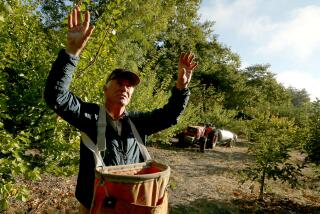Market Watch: How to buy the best cherries

- Share via
Growing cherries is always a roll of the dice for farmers, because if rain falls when the fruits are ripe on the tree, a large portion of them can split and be ruined. You’d think that by late May the main danger would have passed, but J.P. Barbagelata, who is hoping to bring Bings to the Santa Monica market next Wednesday, had the agonizing experience of driving off last Tuesday just as the rain was starting to fall on his farm in Linden, near Stockton. As he drove he heard that a quarter-inch had fallen, and that more was expected.
“That’s enough to do serious damage, but I won’t know the extent for several days,” he said, grimacing.
Most of the growers who sell at farmers markets in the Southland come from Fresno and points south, where less rain fell, so there should still be plenty of cherries here. In terms of fruit quality, cherries have fared much better in this cool spring than peaches and nectarines, which in addition to being a week or so late, have not in many cases had sufficient heat to develop full flavor.
Buying cherries is always a bit of a crapshoot for consumers — the same variety that is tart one week may be perfect the next, and over the hill two weeks later. Good past experience with a grower does count for a lot, but the best way to make sure you’re getting top-quality fruit is to stay nimble and sample from several different vendors before you buy.
When I have the time I prefer to “cherry pick” fruits individually so I can select the largest, darkest, plumpest specimens and avoid malformed, light-colored and damaged fruits. The downside of this strategy is that it can take a long time to pick out the premium fruit, and by the end of the market the best may be gone. If you arrive late, buying prefilled bags or cups of cherries may be a better bet.
Surprisingly often, some vendors, especially at less reputable markets, will set out a display consisting almost entirely of culls — look carefully and you’ll see that almost every fruit has a defect, like a doubled form, or a little spur near the stem. As long as there’s no damage like bird pecks or mold, such fruits are edible, and sometimes taste OK. But they should always sell for substantially less than top-grade fruits, like half-price; if you pay full price for culls you are being rooked.
Good cherries will be dark for their variety and have fresh, green stems, indicating that they were recently harvested. Cherries without their stems are fine if you’ll be eating them within a few days, but they don’t keep as well as fruits with intact stems.
Similarly, look for fruits that are medium to large for their variety. Runts can have decent flavor but are less satisfying to eat, as they have a higher proportion of pit and skin to flesh.
The most common varieties, like Bing, Brooks and Rainier, are of the biggareau type, which is supposed to be firm. But there are a few varieties, such as Black Tartarian, which are of an older type called gean. These are supposed to be somewhat soft, and some of these cherries have the best flavor of all.
Bing, of course, is the classic variety and the standard of quality for cherries, but because it requires a fair bit of winter chill and fares poorly in regions with superhot summers, it is mostly grown upstate near Stockton, which benefits from cool maritime breezes that blow in through the San Joaquin Delta.
Much of Southern and Central California is too hot for best production and quality of Bing and other older varieties, but there are a few local growing districts at higher elevations, such as Leona Valley — famous for its U-picks — Cuyama, Tehachapi and Anza, where cherries grow well. There are also a very few areas close to the coast, such as parts of Lompoc, Santa Ynez and San Luis Obispo, that the maritime influence makes suitable for cherry-growing.
Production in such areas is limited, and at farmers markets there’s tremendous demand for fresh cherries that exceeds the local supply. Some vendors succumb to the temptation to profit by supplementing their supplies of locally grown fruit of superior quality and freshness with fruit purchased at wholesale. Last year, when a huge crop in the Northwest led to dirt-cheap wholesale prices, such cheating appeared to be rampant at many markets with lax management.
It’s difficult for farmers market customers to determine whether an individual vendor is cheating by peddling illicitly purchased fruit, because some growers carry “second certificates” allowing them to sell for one or two other farmers. But if a farm from some improbable cherry-growing locale, like low elevations in San Diego County, sets out copious displays of cherries all the way into August, there’s a good chance they’re buying the same fruit that you could purchase for less at supermarkets.
More to Read
Eat your way across L.A.
Get our weekly Tasting Notes newsletter for reviews, news and more.
You may occasionally receive promotional content from the Los Angeles Times.







